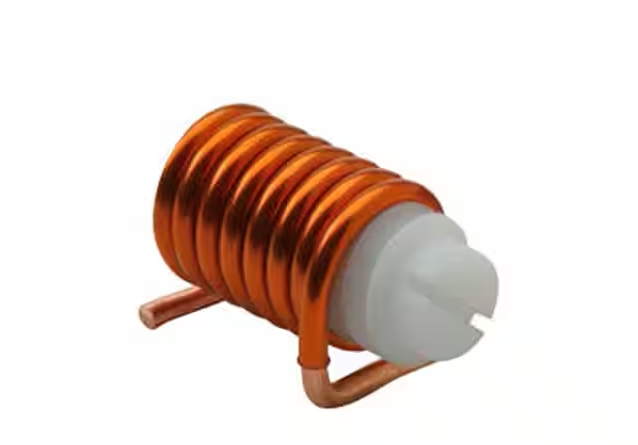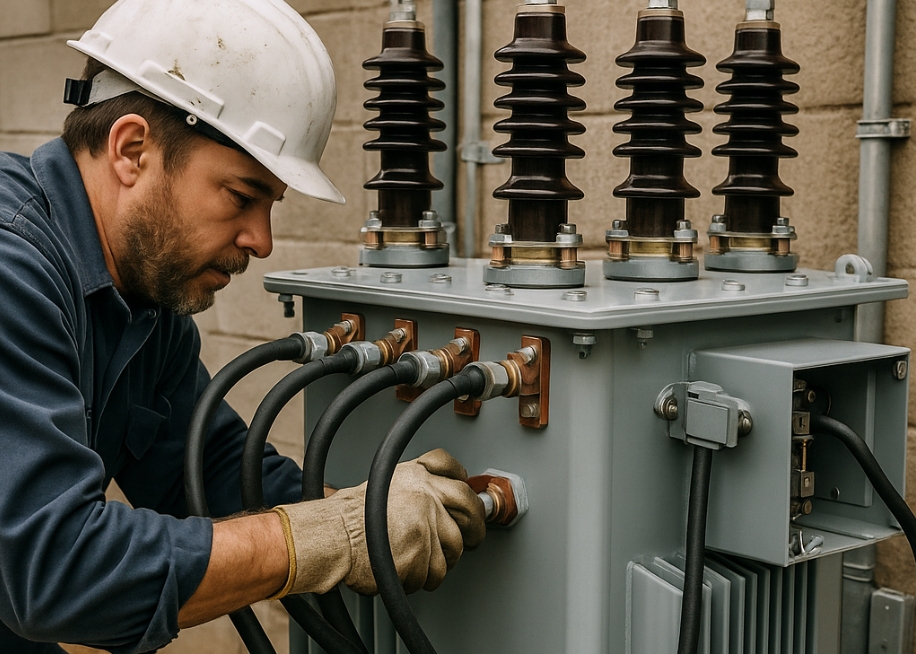Understanding the Basics of Electric Transformers
A Clear and Simple Guide to Electric Transformers
Electric transformers are part of our modern world and they matter a lot. They help move electrical power from one place to another and they make power useful for many devices. People use transformers in big power grids and in small electronics. They help deliver the right voltage to the right place. This guide will explain what transformers do, how they work, what types there are, and how to choose and care for them.

What a Transformer Is
A transformer is a device that moves electrical energy between two or more circuits. It does not move power by direct electric contact. It uses a magnetic link to pass energy from one coil of wire to another. The basic job is to change the voltage level. The transformer can raise voltage or lower voltage. It keeps the same frequency while it changes the voltage. That makes it possible to move power long distance and then make that power safe for use where people live and work.
Transformers have two main parts that matter most. One part is the core and the other part is the windings. The windings are wires that are insulated and wrapped around the core. One winding gets the input power and the other winding gives the output power. The windings are called the primary and the secondary. The core is usually magnetic and it helps the magnetic field reach from the primary winding to the secondary winding. That is how energy moves from one side to the other.
The Main Working Idea
The core idea behind a transformer is electromagnetic induction. When alternating current flows in the primary winding, the current makes a changing magnetic field around the winding. The iron core guides that magnetic field and links it to the secondary winding. When the magnetic field in the core changes, it makes a voltage appear in the secondary winding. This is the key effect that lets the transformer work.
If the secondary winding has more turns of wire than the primary, the transformer makes a higher voltage on the secondary. If the secondary has fewer turns, the voltage on the secondary is lower. The ratio of the turns tells you the ratio of the voltages. This relation is simple and it is very useful for design and use.
The transformer works with alternating current. It does not work with steady direct current the same way. The speed of the change, or the frequency of the AC, matters. The design of the core and the choice of materials also matter for how well the transformer works.

Basic Parts and How They Fit
The core is usually made of stacked thin sheets of silicon steel. The sheets are thin so they cut down the eddy currents and keep losses low. The core gives a low reluctance path for the magnetic flux and it helps link the windings tightly.
The windings are copper or aluminum wire. The wire is coated or wrapped so it is insulated. The primary winding gets the supply. The secondary winding gives the output to the load. The windings may be placed in layers. The shape and placement affect how much coupling you get between the primary and secondary. Good coupling means less energy lost to stray fields.
The insulation between windings matters too. It keeps the high voltage side from touching the low voltage side. That is important for safety. The insulation also must handle heat and moisture and mechanical stress.
Some transformers use oil to help cool and to improve insulation. Those are usually called oil-filled transformers. Others use air and fans to cool. The cooling way depends on size and on how much heat will be made.
How Voltage Changes Happen
The voltage change depends on the turn count in each winding. If the primary has N1 turns and the secondary has N2 turns, then the voltage ratio V2/V1 is N2/N1. That is the basic math rule. So designers choose the turns to get the voltage they need.
When the load draws current from the secondary, some current flows in the primary too. The transformer keeps power balance except for losses. If the secondary voltage is higher than the primary, the device raises the voltage and lowers current in the same proportion, and vice versa.
This change makes it safe to move power over long distances. High voltage means lower current for the same power, and lower current means less energy lost as heat in the wires. That simple fact makes the electrical grid possible.
Types of Transformers and Where They Are Used
There are many types of transformers and each one has a clear job. Power transformers sit at power plants and in substations. They step voltages up or down for long distance lines. Distribution transformers sit near neighborhoods. They lower voltage to the level people use in homes and small businesses. Isolation transformers separate one circuit from another to add safety and to reduce noise. Autotransformers use a shared winding for part of the circuit and they save material and money in certain uses. Special transformers handle audio signals, pulses, or measurement tasks like current and voltage sensing.
In small electronics, transformers still matter. Devices that must work with mains power often include a small transformer. Some power supplies use a transformer to get the right voltage before other circuits like integrated circuit chips get power. Integrated circuits need well controlled voltage and signals. A transformer helps by keeping the input at the right level and by isolating the circuit from the mains when needed. So transformers and integrated circuits often work together inside devices. The transformer makes the raw mains power safe and usable and the integrated circuit does the precise control or processing once the voltage is right.
Transformers in industry supply motors and machines. Transformers in buildings give power to HVAC, lifts, and lighting. Transformers in audio gear shape the signal level and help match impedances. In test equipment, transformers provide safe isolation for measuring devices.
Efficiency and Losses in Simple Terms
Transformers are usually very efficient. Many get efficiency in the high 90s percent for large units. But they still have losses. The losses are mainly in two places. One is in the core where the magnetic material changes with the magnetic field and that makes heat. This is called core loss and it has two parts: hysteresis loss and eddy current loss. The other loss is in the windings where the wire resistance makes heat. That is the copper loss. The load size affects copper loss more because higher current makes more heat in the wires.
Designers work to cut losses. They use good materials for the core and thin laminations to cut eddy current loss. They use large enough wire or special winding patterns to cut copper loss. They also design cooling systems to take the heat away.
Cooling affects life and reliability. If the transformer runs hot, its insulation will age faster and the device will fail sooner. So cooling is not a minor issue. It matters for safety and for long service life.
Cooling Methods and Why They Matter
One common cooling way is oil cooling. The windings and core sit in oil. The oil moves heat away and often passes the heat to radiators. Oil cooling works well for big transformers because oil moves heat well. Another way is air cooling. Fans or natural air flow help. Air cooling is simpler and common in small units.
The choice of cooling depends on how much heat will be made and on where the transformer sits. Outdoor and large units often use oil cooling. Indoor and small units often use air cooling. Some designs use both methods or forced air and a small oil volume.
A design that cools well runs cooler and lasts longer. A design that fails to cool will overheat and fail.
Noise and Vibration
Transformers make sound when they work. The magnetic core and mounting can vibrate as the field changes. That vibration becomes sound. Sound depends on the size, on the mounting, and on the load. In places where low noise is needed, designers add features to cut vibration like damping mounts or special core clamps.
Noise does not mean the transformer does not work. But very loud noise can show a loose part or a fault. If the noise rises suddenly, check the device. Old or loose parts can make noise and cause failure.
Safety and Protection
Safety is central. Transformers must have good insulation and secure connections. They also need ground connections and protective devices. Fuses and circuit breakers can stop dangerous current. Relays can trip the breaker fast when a fault appears. Temperature sensors can shut down or alarm if the transformer overheats. Pressure relief devices release pressure if an internal fault causes gas build up.
For small installations, isolation transformers help protect users and sensitive devices. For large installations, protective relays coordinate with the grid protection to isolate a fault and keep the rest of the system safe.
For every transformer, follow the installation rules. Use the right clearances, safe supports, and good grounding. Inspect and test before you use the device.
Installation and Routine Checks
Install the transformer on a solid base and make sure it is level. Check the wiring and tighten the connections. Make sure fans or radiators have space to work. Connect the ground. For oil cooled units, check the oil level and the insulation of the oil.
Do simple checks often. Look for oil leaks, listen for strange noise, and feel for hot spots. Measure temperature and record it. Check the insulation resistance and measure the winding resistance on a schedule.
If you see rising temperature, higher noise, or oil problems, stop and check. Small signs can warn of big issues. Fix the issue quickly to avoid a major failure.
Tests to Know and Use
Before putting a transformer into service, test the insulation, measure the turns ratio, and measure the short-circuit impedance. These tests show that the transformer matches design and that there are no major faults.
In service, use partial discharge tests for high voltage units and check dissolved gas in oil for oil-filled units. The gas test shows if there was arcing or overheating inside. The trend of the gas data matters. Capture and save data so you can see changes.
Good testing helps you plan maintenance and avoid surprise outages. Test results show when to clean, repair, or replace parts.
Choosing the Right Transformer in Simple Steps
First find the load and how much power it needs. Next find the voltages on the supply side and on the load side. Then choose the capacity that fits the load and leaves room for future growth. Also decide the cooling way and the installation place. If you need isolation, pick an isolation transformer. If you need a low cost small change of voltage, consider an autotransformer but remember it gives less isolation.
Choose a unit with a good efficiency and a clear service history from the maker. Look for the right safety approvals and local standards. Good service and spare parts make operation easy and safe.
Transformers and Integrated Circuits
Transformers and integrated circuits often work together in modern devices. Power supplies use transformers to get the right voltage and to provide isolation from mains. After the transformer, integrated circuit parts manage regulation, switching, and control. The integrated circuit needs stable input and protection. If the transformer does not keep the voltage and isolation stable, the integrated circuit may fail.
In many small power supplies, the transformer sits before or inside the power module. The integrated circuit then does the fine work like regulation, sensing, and feedback. The transformer keeps the high energy stage away from the low voltage control logic that uses integrated circuits. That separation keeps the control circuits safe and reduces noise.
Audio gear also shows a link. The transformer can help match levels and reduce hum before the integrated circuit amplifier or processor. In measurement gear, transformers isolate the high voltage parts and let the integrated circuit read signals safely.
When you design a circuit with integrated circuits, plan the transformer size and type early. The right transformer helps the whole device work better and last longer.
At joydo you can find high quality Integrated Circuits:https://www.joydo-ele.com/
Common Faults and How to React
Common issues are overheat, oil leak, high noise, bad insulation, and faulty coolers. If you see smoke, trips, or strange noise, stop the system and check. Do not run a badly damaged transformer. If a fault is internal, it may need repair or replacement. Some faults show early in tests like the dissolved gas in oil or shifting impedance values. Watch the trends.
If you must work on a transformer, isolate it and follow lockout-tagout rules. Always discharge stored energy and test for voltage before you touch wiring.
Life Expectancy and Replacement Signs
Many transformers live for decades if they are kept cool and dry. The insulation life is often the limiting factor. If the insulation ages, the risk of failure rises. Signs you might replace a transformer include more frequent faults, rising oil gas levels, excessive noise, or repeated hot spots.
Plan for replacement before a failure that affects service. A planned change is safer and cheaper than an emergency replacement.
Modern Trends in Simple Terms
Designers add sensors and remote monitors so you can check the transformer from far away. That helps spot problems early. New core materials and better winding methods lower the losses. New insulating fluids reduce environmental risk. Some designs are smaller and lighter to fit tighter spaces.
Smart monitoring tells you the real use and the real temperature, so you can run the device closer to limits safely and still protect it when needed. That saves money and avoids surprise failure.
Real Uses That Matter
Transformers are in power stations, substations, factories, buildings, and homes. They are in chargers and in audio gear. They work with motors and with computers. They work with integrated circuits inside power supplies and with big machines that need high power. The same idea fits many scales from small electronics to big grid equipment.
Every place that needs a different voltage or isolation can use a transformer. The transformer makes power safe and practical and gives the right voltage for the job.
Simple Summary
Transformers move electrical energy between circuits without a direct electrical link. They do this by using magnetic fields and coils. They change voltage levels up or down and keep frequency the same. The core and the windings are the main parts. The turns ratio sets the voltage change. Designers watch core loss, copper loss, and cooling to make transformers last and to keep them efficient.
Transformers work with integrated circuits in many devices. The transformer supplies safe power and the integrated circuit controls and uses that power. Keep transformers clean, cool, and tested. Use simple safety rules and good protection. With good design, a transformer can run well for many years and help the electrical system work reliably.
If you want, I can make this article into an SEO-ready web page in English, or translate it to another level of technical detail with diagrams, calculations, and formulas. I can also include a short section that directly links transformers to integrated circuit power stages with a simple circuit diagram and parts list. Tell me which one you want and I will do it.









